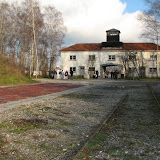Dachau Concentration Camp
Today we start our Christmas trip. Everything is packed and stored at Dave and Karen's and we leave with our backpacks on. The flight from Heathrow to Munich is a bumpy one, so much so that we can't even get a hot drink.
We get a car in Munich and head straight to Dachau. Dachau is an industrial town outside of Munich. It has one of largest and first concentration camps used by the SS from 1936-1945. Many of the original buildings and non-camp areas no longer remain, but it has been built back up as a remembrance site. The guard towers still dot the perimeter and the original gatehouse is constructed to give visitors the feeling of being led into the camp - through gates that read 'Arbeit macht frei' - Work brings freedom.
What strikes you about the camp is that it is such a large area. There are prisoner barracks lined towards the back of the camp, each barrack being 10x100m. Each barrack had sleeping quarters and a living area. The sleeping quarters had bunks three high and the beds were no wider than 2-3 feet.
The barracks are separated from the main building by a roll call area, which is a wide expanse where prisoners would stand for hours on end at the whim of an SS officer. The main building now has a museum. Towards the back of the camp are memorials from some of the main religious groups involved in the camp - Jewish, Catholic, Protestant.
Outside the main camp area is the crematorium. It is here that the bodies of dead prisioners were incinerated. In the 'new' crematorium are the gas chambers. Although there is no record of these particular ones ever be used, they were obviously designed for mass murder of prisoners, who would then be incinerated.
The memorial site is a sobering area, one of the many throughout the German occupation. In memory to the attrocities performed in camps like these there is a simple message on the memorials - Never again.
We get a car in Munich and head straight to Dachau. Dachau is an industrial town outside of Munich. It has one of largest and first concentration camps used by the SS from 1936-1945. Many of the original buildings and non-camp areas no longer remain, but it has been built back up as a remembrance site. The guard towers still dot the perimeter and the original gatehouse is constructed to give visitors the feeling of being led into the camp - through gates that read 'Arbeit macht frei' - Work brings freedom.
What strikes you about the camp is that it is such a large area. There are prisoner barracks lined towards the back of the camp, each barrack being 10x100m. Each barrack had sleeping quarters and a living area. The sleeping quarters had bunks three high and the beds were no wider than 2-3 feet.
The barracks are separated from the main building by a roll call area, which is a wide expanse where prisoners would stand for hours on end at the whim of an SS officer. The main building now has a museum. Towards the back of the camp are memorials from some of the main religious groups involved in the camp - Jewish, Catholic, Protestant.
Outside the main camp area is the crematorium. It is here that the bodies of dead prisioners were incinerated. In the 'new' crematorium are the gas chambers. Although there is no record of these particular ones ever be used, they were obviously designed for mass murder of prisoners, who would then be incinerated.
The memorial site is a sobering area, one of the many throughout the German occupation. In memory to the attrocities performed in camps like these there is a simple message on the memorials - Never again.
Click on the photo to see more of Dachau
We left Dachau and drove west through Bavaria to Ulm. These winter days aren't going to offer us much light for sight seeing. We arrive in Ulm at Steven and Carolin's. Ulm has Christmas markets on in the main square and we sample some Gluhwein to warm ourselves up. It is much liked mulled wine. Ulm is quite cold and we head to a restaurant in the fish area for some dinner and beers.




No comments:
Post a Comment